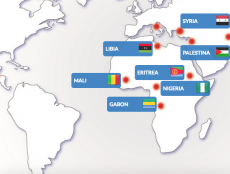
Articles
Editor’s Picks
Higher Education
Industry News
Public Universities Bank on Distance Learning and Emerging Markets to Offset Enrollment Declines
By Henry Kronk
June 01, 2019
Will emerging markets offset the North American college enrollment decline? That’s the question numerous institutions are currently asking. A new report out from Technavio provides tentatively optimistic forecasts, projecting global distance learning to grow at a CAGR of 9% through 2023 to reach an estimated value of $90.37 billion. The major players identified, furthermore, are all public universities.
North American higher education enrollments have been on the decline for eight consecutive years. By most projections, that decline will continue throughout most of the next decade. For universities and colleges still recovering from massive cuts in state appropriations following the Great Recession, that’s bad news. Many view the situation as a question of adapt or perish, and numerous small colleges have already gone the latter route.
Enrollment Declines and College Closures Will Get Worse Before they Get Better
Education Dive has been tracking college closures since 2016. Due largely to regulatory pressure, college closures have far and away been led by the for-profit sector. The publication reports that over 100 for-profits closed between 2016 and 2018, while 30 non-profits have shut their doors. In December, however, Fitch Ratings projected these closures to increase in 2019.
One strategy might save the day, at least for some. The costs of PCs, mobile devices, and internet connections is falling in regions throughout India, China, and the continents of Africa and South America. The number of digital users, therefore, is set to increase or, potentially, explode. India added 37 million new mobile device users in 2018 alone, bringing the total number to over 335 million, according to Grey Matters Capital. GSMA, in their 2019 The Mobile Economy report, projects that figure to breach 1 billion by 2025.
Institutions Have Already Tapped Distance Learning Marketed Toward Emerging Markets
To many North American institutions, these new digital users represent an opportunity. In May, Inside Higher Ed reported how Hudson Valley Community College (HVCC) based in Troy, New York, will begin marketing in-person and remote courses to learners in Costa Rica and Trinidad as soon as this summer. In coming years, they hope to expand their scope in Central and South America.
“With community colleges, everybody does what everybody else is doing. I want to make sure Hudson Valley is not among the competition but that we’re out there and we’re different,” HVCC president Roger Ramsammy told Inside Higher Ed. “In order to maintain this college, you have to go far out and make yourself indispensable. We will be an international college.”
The Technavio report “Global Distance Learning Market by Type and Geography” published on May 31 projects the largest growth to occur in the Asia Pacific region.
Public Institutions Lead the Charge
The major players they identify, surprisingly, are all public institutions. They include: Arizona State University, the University of Missouri System, and the University of Wisconsin system in the U.S. They also name Aston University and the University of Exeter—two public research institutions in the UK.
Technavio researchers expect credentialing and more discrete forms of education—referred to by some as micro- or nanolearning—to play a part.
But at least in the 2017-18 school year, traditional degree paths accounted for the majority of the market, and that may remain unchanged going forward.
“The traditional distance learning market held the highest share during 2018 due to the increased enrollments from unconventional students, including working professionals,” the company said in a statement. “Furthermore, supportive government initiatives in both emerging and advanced economies will eventually increase the credibility of distance learning degrees in the forthcoming years.”
Featured Image: Sharosh Rajasekher, Unsplash.









No Comments